Browse Houses
Search Results: Returned 5927 records. Displaying results 3201 – 3300
| House name | Description | |
|---|---|---|
| Jane Mount | Pierce Mahony's estate was leasing this property to Jeremiah Dillane at the time of Griffith's Valuation, when it was valued at £7 5s. Bary states that the house is believed to have been built by Gun Cunningham in the eighteenth century. It passed through marriage to the Mahony family. The Dillon family have been in possession of the property since before the Famine. The original house is now ruined. | |
| Janeville | A house located very close to the county Tipperary border, occupied by the Reverend R. Lloyd in 1837 and by Samuel R. Harding at the time of Griffith's Valuation. The buildings were valued at £17+ and held from Thomas L. Sadlier. | |
| Janeville (Bandon) | Rev. Henry Gillman was leasing this property from the Cornwall family in 1851 when it had a valuation of £33. It is labelled Janeville on both the 1st and 25-inch Ordnance Survey maps. The house is still extant and now known as Eversleigh House. |
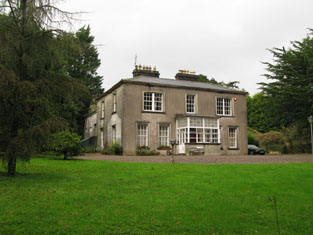
|
| Janeville (County Waterford) | Janewille House was vacant at the time of Griffith's Valuation, when it was part of the Ussher estate and valued at £22 10s. A second house [X027936] in the same location was leased by Henry Smyth from the Ussher estate and valued at £15 10s. In 1837 Lewis refers to Janeville as the seat of A. Keily. Wilson, writing in 1786, refers to it as the seat of John Keily. The house is no longer extant. | |
| Jockeyhall | A Blackall residence in the 18th century, by the mid 19th century Jockeyhall was on the Tuthill estate and occupied by Patrick Dundon. This house was included in the sale of the Tomkins estate in 1861 when held by the representatives of George Tuthill. |
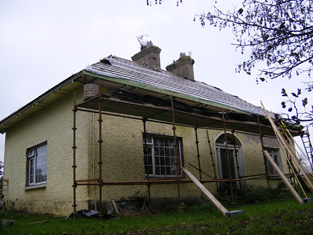
|
| John's Hill House | Occupied by Captain Simon Newport at the time of Griffith's Valuation, when it was valued at £28. Newport was leasing it from his wife's uncle, Robert H. Paul. It is labelled Bishop's House on the 25-inch Ordnance Survey Map of the 1890s when it had become the residence of the Roman Catholic bishops of Waterford and Lismore. | |
| Johns Port | The residence of Maurice Hodson in 1814 and at the time of Griffith's Valuation held by John Hodson in fee. It is no longer extant. | |
| Johns Port House | At the time of Griffith's Valuation owned by Alexander Gunning in fee and valued at £10. Labelled Johnsport House on the 1st edition Ordnance Survey map and as St. John's House on the later 25-inch edition of the 1890s. It is still extant and offers guest accommodation. See www.stjohnshouse.biz. |

|
| Johnsgrove | Originally a Glover family home, by the time of Griffith's Valuation it was occupied by Francis F.P. Holmes and held from Walter Nugent. The buildings were valued at £30. This house is still occupied. |

|
| Johnstown | Built circa 1782 by Colonel John Dillon and held on a lease in perpetuity from the Incorporated Society for Promoting English Protestant Schools in Ireland. The Ordnance Survey Name Books refer to this fine residence, occupied by D. Kelly. The Dillons were in residence again by the time of Griffith's Valuation. It became the home of the Kelly family in the early 1870s until the late 1920s. Demolished by the Land Commission, only the entrance gates still remain. | |
| Johnstown House | Johnstown was the home of Sarsfield Esq in the 1770s and 1780s. William Martin is recorded as resident at Johnstown in 1814 and Mrs Palmer in 1837. John Courtney occupied the house valued at £21+ in the early 1850s. He held it from the Earl of Bandon. The original house is not extant. | |
| Johnstown House (Decies) | Mrs. Mary Barron was leasing this property from the Villiers-Stuart estate in 1851 when it was valued at £10 10s. There is still an extant property at the site. | |
| Johnstown Park | This house was built for Peter Holmes, MP, c. 1777 and probably designed by William Leeson. It was originally known as Peterfield. It was leased to Samuel Prendergast in 1823. Lewis records J.G. Prendergast as resident in 1837 and the Ordnance Survey Name Books refer to it as the residence of Counsellor Prendergast in 1840. The house valued at £49 was occupied by Thomas G. Prendergast in the mid 19th century and held from the representatives of Peter Holmes. From 1865 to 1936 Johnstown was the home of the Headech family. The house was unroofed in the early 1940s and is now demolished. |

|
| Jones Lake | A house south of the railway line and a short distance west of Moate in the mid-19th century. O'Brien writes that it was built by the Jones family in the mid-18th century as a two storey, three bay building. Leet records William Gustavus Jones as resident in 1814. Occupied by John Sills at the time of Griffith's Valuation (publ. 1854) and held from Patrick Dillon Irwin with about 50 acres, when it was valued at £13. |

|
| Jordanstown | A house valued at £14 was occupied at Jordanstown by James Buckley at the time of Griffith's Valuation and held from Sir Edward Tierney. Hajba writes that the Buckleys continued to live at Jordanstown for the rest of the 19th century. Sold to Patrick Walshe in the early 20th century this house is no longer occupied. |

|
| Joristown | Joristown House, set in a large demesne, with a deer park to the west, as recorded on the first edition OS map, this was a Purdon home from the early 19th century as Peter Purdon was resident in 1814 and 1837. At the time of Griffith’s Valuation (publ. 1854) the house was unoccupied, valued at £16 and held from Augustus C Purdon. Shepherd Hugh Lambe was living in a house in Joristown with two of his cousins, held from General Purdon in 1901 and John Purdon in 1911. This house is now demolished. |
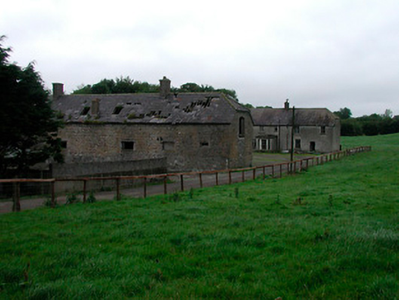
|
| Joycegrove/Brownesgrove | A house at this site was occupied by the Joyces in the 1770s and in 1814. It is shown on the first edition Ordnance Survey map at M466578. The porperty was later acquired by the Browne family and is labelled Browne's Grove on the 25-inch map of the 1890s. A modern house is located in front of the site of the nineteenth century house. The impressive entrance gates still remain. |
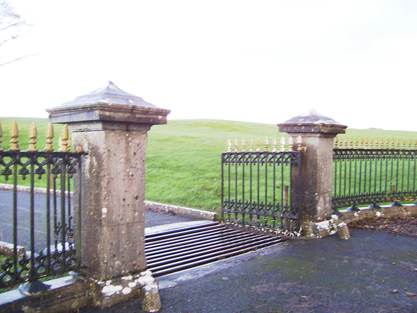
|
| Keale House | The seat of a branch of the Leader family in the 18th and 19th centuries, sold by them in the early 20th century. The buildings were valued at £22+ in the mid 19th century and the property was held by John Leader from Thomas G. French. The National Inventory of Architectural Heritage suggests the present house was built in 1834. It is still extant and well-maintained. |
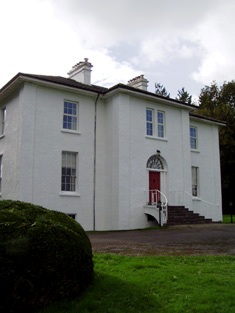
|
| Keamagaragh House | Rev. Samuel Hornibrooke was leasing this property to Rev. John Pratt in 1851 when it was valued at £12. It is still extant. | |
| Kedagh Park | Held by Bartholomew Kelly in fee at the time of Griffith's Valuation when it was valued at £11 10s. The house is labelled Kedagh Park on the First Edition Ordnance Survey map but as Clondoyle House on the 25-inch map of the 1890s. A house still exists at the site. | |
| Keel House | Edward Rae was in possession of Keel House at the time of Griffith's Valuation. Lewis records it as the seat of Giles Rae in 1837. Bary states this was originally a Langford House, possibly built as far back as the 1680s but with later modificiations. Wilson refers to it as the seat of Mr. Langford in 1786. It passed by marriage to the Rae family with whom it remained until the twentieth century. It was sold but later re-purchased by the family and is still extant. |

|
| Keenagh | Described at the time of Griffith's Valuation as a steward's house, held in fee by Percy Magan and valued at £4.10. The ruins of the building still exist at the site. |

|
| Keenagh Lodge | A sporting lodge of the Palmer family. | |
| Keenaghan Mill | At the time of Griffith's Valuation John and Henry Gorman were leasing an extensive milling complex at Keenaghan, barony of Corran from Robert Gore Booth, then valued at £83. |

|
| Kells House or Hollymount Cottage | Roland Blennerhassett was leasing this property to Richard Blennerhassett at the time of Griffith's Valuation, when it was valued at £5 15s. Bary states that he built the original house here in the 1830s which he called Hollymount Cottage. It later became known as Kells House and continued in the Blennerhassett family until the twentieth century. In 1906 it was the property of Rowland Blennerhassett and valued at £5 15s. It has had a number of owners since and is now a successful plant nursery with gardens open to the public. see www.kellsgardens.ie. | |
| Kellybrook | Wilson records this house as a Kelly residence in 1786. The seat of Denis Kelly in the 1830s and of Jane Kelly in the 1850s who held the property from Esther Dillon and the representatives of Maria Boswell. The house was valued at £3. Still occupied by a family named Kelly. |

|
| Kellysgrove | Wilson refers to Kellysgrove as the seat of Mr. Kelly in 1786. In 1837 Lewis recorded Kellysgrove as the seat of W. Kelly. The house was occupied by Charles Denis Kelly at the time of the Encumbered Estates court sale in December 1850. At the time of Griffith's Valuation, the house at Kellysgrove, parish of Clontuskert, valued at £20, was leased by Robert St. George from the Earl of Clancarty's estate. The original house is no longer extant. |
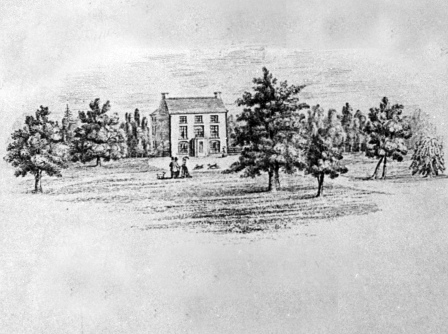
|
| Kenmare Castle | Joseph Gubbins of Kenmare Castle is recorded in 1814. Lewis refers to the pretty cottage erected by J. Gubbins on the site of Kenmare Castle in his entry for the parish of Hospital, circa 1837. James Gubbins was residing in a house valued at £23 at the time of Griffith's Valuation. He held the property from the Earl of Kenmare. |

|
| Kenmare House (Killarney House 1) | The original house used by the Browne family, Lords Kenmare, was located in the Demesne. It is named Kenmare House on the 1st edition OS map and by Lewis in 1837 but later came to be called Killarney House. At the time of Griffith’s Valuation, the property was valued at £90. Bary states that this house was probably constructed in the early 18th century. In 1872 the 4th Earl decided to build a new house and the original house was demolished. The later Killarney House was located in Knockreer townland. | |
| Kent Lodge | Richard O'Connell was leasing this property from the Denny estate at the time of Griffith's Valuation, when it was valued at £10 10s. Bary states that this house was attached to an earlier building known as O'Connell's Cottage where Rickard O'Connell lived but that Kent Lodge was built by William Collis. The house, which is still extant, remained in the Collis family until the early twentieth century. |
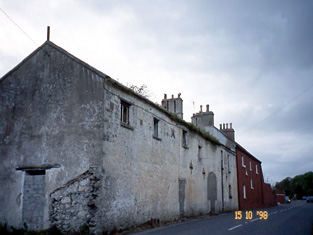
|
| Kentstown | The sales rental of June 1851 records the leasing of Kentstown, by Netterville and Geoffrey Davies, to Thomas Davies, for 31 years from 10 July 1838. It was held in fee by him at the time of Griffith's Valuation when it was valued at £12. In the 1877 sales rental the house was described as having "a parlour, drawing room, 6 bedrooms, kichen, dairy and servants' hall". A house is still extant at the site. | |
| Keoghville | Built by Laurence Keogh and his wife Mary Fallon at the end of the 18th century. They were the grandparents of Judge Keogh. Described in the Ordnance Survey Name Books as still in the occupation of Keogh, the representaive of the ancient proprietors of Doohy-Keogh 'but he is poor and nearly shook'. This must be Ross Keogh who resided in Keoghville in 1837. By the time of Griffith's Valuation the house was held in fee by John McKay and valued at £15. Abandoned in the 20th century and replaced by a modern bungalow, the yard is still in use. |

|
| Keonbrook | In 1783 Taylor and Skinner record Kanebrook but not the name of the family whose residence it was. Keonbrook, the residence of the Keon family, was occupied by John F. Tottenham in 1856. In 1906 it is recorded as the property of Bridget Mollahan and was valued at £14. A modern house has been constructed in the demesne. | |
| Kevinsfort | Kevinsfort House was built c.1820. It was the home of various other families at different times in the 19th century, including Capt. George Dodwell. At the time of Griffith's Valuation it seems to have been leased by Alexander Popham to John Stoll and valued at £52. McTernan notes that Popham was Dodwell's son-in-law. The property was sold by the Pophams in 1923. Kevinsfort is still extant and occupied. |

|
| Keylong | In 1786 Wilson refers to this house as the seat of Mr. Butler. Key-long was the residence of Richard Butler in 1814 and in the early 1850s Richard Carew was the occupier, holding the house valued at £12 from Thomas Going. This house is still a family residence. |
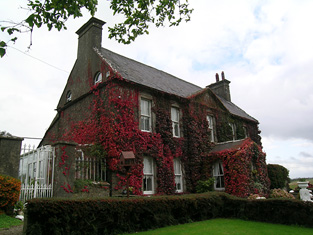
|
| Kilballyowen | In 1786 Wilson refers to Kilballyowen as the seat of Mr. O'Grady. This was the main seat of the O'Grady family, described by Lewis as a "handsome modern building" circa 1837. At the time of Griffith's Valuation the buildings were valued at £41. By 1906 they were valued at £70 and the property was still in the possession of 'The O'Grady'. The Irish Tourist Association surveyor lists the types of artifacts, paintings etc to be found in this home of Madam O'Grady in 1942. The house was demolished post 1968. |
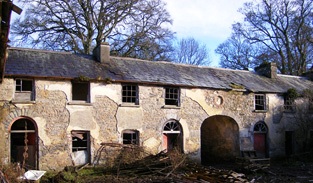
|
| Kilballyowen Lodge | A house on the Westby estate occupied by Thomas Keane at the time of Griffith's Valuation and valued at £8. The house was the home of George Copland Studdert in the 20th century. | |
| Kilbarron | A property originally associated with the Ryan family. Mr Robert McGrath was residing at Kilbaron in 1814 and in 1837 Lewis records that E. McGrath rebuilt the house "on the site of the old mansion". At the time of Griffith's Valuation the buildings valued at £6.5 shillings were held by Edward McGrath in fee. The house is now a ruin. | |
| Kilbarry | In the mid 19th century occupied by George Wise and held from James H. S. Barry. The buildings were valued at £35. | |
| Kilbarry (Castlelyons) | Hajba writes that a new house was built here in 1842 by the Wigmores. Robert Wigmore was resident in 1814, E[dward] Wigmore in 1837 and Henry Wigmore in the early 1850s when the buildings were valued at £23 and held in fee. In 1786, Wilson states that it was the residence of Hon. Mr. Moore. Later the home of the Kent and Waters families. Still extant and occupied. |

|
| Kilbarry (Gaultiere) | John Hartry was leasing this property from the Lane-Fox estate at the time of Griffith's Valuation, when it was valued at £12 5s. The property is no longer extant and major modern development has taken place in the area. | |
| Kilbarry House | The Barrys were resident at Kilbarry from at least the latter part of the 18th century. J. Barry was occupying the house in 1837 and Nicholas Barry in the early 1850s when it was valued at £11. Nicholas Barry held the property from Henry Hatchell and Thomas Leader. A house is still extant at the site. | |
| Kilbarrymeadan | In 1851 John Casey was leasing this property from the Earl of Stradbroke's estate, when it was valued at £17. It is still extant and occupied in the village of Kill, county Waterford. |

|
| Kilbeg Lodge | The seat of John Scanlan circa 1840 and of Sarah Scanlan in the early 1850s, held from William Scanlan and valued at £14. In 1906 occupied by William Scanlan and valued at £10. | |
| Kilbegly House | At the time of Griffith's Valuation, John Dillon was leasing a house valued at £20 at Kilbegley, barony of Moycarn, to William Colohan. In 1837 Lewis records Kilbegley as the residence of B. Newcomen. In the same year it is recorded in the Ordnance Survey Name books as "a gentleman's place, two stories high, in good repair". The 25-inch map of the 1890s indicates alterations to the house. Only ruins remain at Kilbegly now. | |
| Kilbegnet House | Occupied by John Shiel at the time of Griffith's Valuation and valued at £25. The property is labelled Kilbegnet House on the 25-inch edition of the Ordnance Survey map. A house is still extant at the site. | |
| Kilberrihert | A house which was the residence of R.E. Crooke in 1837 but was unoccupied in the early 1850s. At that time it was valued at £20+ and Thomas E. Crooke was the lessor. A building is extant at the site. | |
| Kilboglashy | At the time of Griffith's Valuation, Harloe Phibbs was leasing a house valued at £8 as well as mill buildings valued at £300 to Robert Culbertson, at Kiboglashy, Almost all traces of the huge mill complex in Ballysadare have now been demolished and modern building development has taken place there. |

|
| Kilbolane | Home of the Barry family in the late 18th and 19th centuries located on the Evans estate. Occupied by Edward Robert Caulfield Barry in the early 1850s when the house was valued at £39. There was also a flour mill closeby. Sold by the Barrys at the end of the 19th century to David O'Leary Hannigan and later purchased by Milford Creamery who demolished the house in the mid 20th century. |
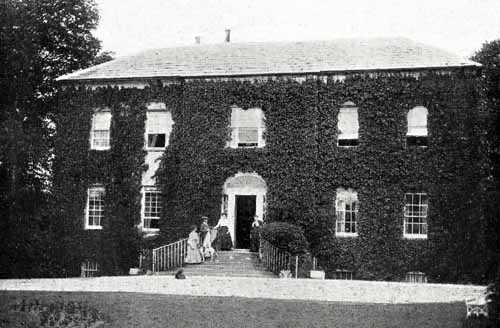
|
| Kilboy | Francis Rowland was resident in 1837 and at the time of Griffith's Valuation, when the house was valued at £35 and held from Wallis Adams. It is now a ruin. | |
| Kilboy | In 1786, Kilboy was described by Wilson as the fine seat of Henry Prittie. Lord Dunalley is recording as resident at Dunally Castle, Nenagh, in 1814. In 1837 Lewis writes that Kilboy, the seat of Lord Dunalley, "was erected about 60 years since". In the mid 19th century it was valued at £76+ and held in fee. This house, which the National Inventory of Architectural Heritage describes as a "detached five-bay single-storey house over basement, built c. 1775" and designed by William Leeson, was destroyed in 1922. A similar house was erected on the site but was demolished in 1955. A smaller house is now located on the site. |
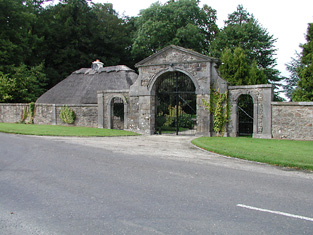
|
| Kilboy/Keil Bui | Marked as Keil Bui in the townland of Kilboy on the first Ordnance Survey map, occupied by Lewis Gibson in 1814 and by John Gibson in the early 1850s who held the property in fee. The buildings were valued at £25. This house is described as a former deanery in the National Inventory of Architectural Heritage and is now in use as a private residence. |

|
| Kilboyne | Described at the time of the first Ordnance Survey as a 'good house surrounded by a neat but small demesne'. At the time of Griffith's Valuation it was held in fee by Sir Samuel O'Malley and valued at £12. A modern house exists at the site now. | |
| Kilbrack | Hajba writes that this house was built by William Stawell who married Catherine Creagh of Creagh Castle. William was succeeded by his nephew the Reverend Francis Stawell in 1830. Kilbrack remained in Stawell possession until the end of the 19th century. It is still a family home. |

|
| Kilbrack Cottage | Occupied by Michael Creagh in 1814 and by Reverend E.P. Sheehan in 1837. Father Sheehan's representatives were the occupiers at the time of Griffith's Valuation. They held the property valued at £25 from the representatives of Michael Creagh. Kilbrack Cottage is still extant. The National Inventory of Architectural Heritage indicates that it was built c.1760. |

|
| Kilbracken | William Murray Hickson was leasing the house at Kilbracken, barony of Carrigallen, from Elizabeth Armstrong at the time of Griffith's Valuation when it was valued at £20. In 1814 a house at Kilbracken was recorded as the residence of Mr. Armstrong but it has been estimated that the present Kilbracken House was built around 1825. It is not named on the first edition Ordnance Survey map though there are buildings marked on the site. A poster in Leitrim County Library indicates that it was the property of Thomas S.Jones in 1905 when it was offered for sale. The house is still extant and undergoing restoration. |

|
| Kilbree | Kilbree belonged to the Boles family at the beginning of the 18th century. It became the residence of a branch of the Adams family in the late 18th and 19th centuries, occupied by S.W. Adams in 1837. The house was valued at £33 in the mid 19th century and held from Dorothea and William Boles. |
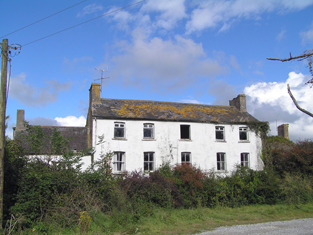
|
| Kilbree House | At the time of Griffith's Valuation, Phillip Chearnley was leasing this property from Matthew Whelan when it was valued at £28. There is still an extant house at this site. Another property in this townland is referred to in ITA Survey of the 1940s as Kilbree Castle. This building, described as "in ruins" on the 25-inch Ordnance Sirvey map of the 1890s, had been reconstructed and was occupied at the time of the survey by Gerald Stuart. In 1786 Wilson mentions that Kilbree had "formerly belonged to the Knights Templars". Buildings are still extant at the site. | |
| Kilbreedy | A house occupied by Michael Nash at the time of Griffith's Valuation and held from the Reverend William Waller, valued at £11. | |
| Kilbride | Kilbride House is a three-bay two-storey house, built about 1810 to the north of Kilbride Castle. The Norths were in possession of Kilbride in the 18th century and Mrs North was resident in Kilbride House in 1814. The list of subscribers to Lewis’ Topographical Dictionary in 1837 includes A J Pilkington of Kilbride Castle. He was married to Mary daughter of Roger North. At the time of Griffith’s Valuation (publ. 1854) the house valued at £9 was occupied by Abraham Pilkington who held it from the representatives of R W Cooper. James King and family were resident at Kilbride in 1901 and 1911. |
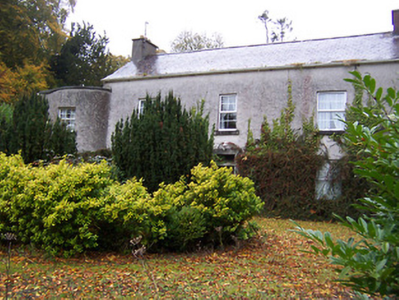
|
| Kilbrittain Castle | William Stawell held this property in fee at the time of Griffith's Valuation, when it was valued at £70. The original castle dates from the 15th century but the property was extensively re-modelled in the eighteenth and nineteenth centuries by the Stawell family. Lewis records it as the seat of Mrs. Stawell in 1837. In 1906 it was the property of Col. William Stawell and valued at £182. It was partially damaged by fire in 1920 following its occupation by British force during the War of Independence. In 1942 the Irish Tourist Association Survey recorded a detailed history of the castle and its association with the Stawell family. In recent years some of the building has been restored. |

|
| Kilbrittain Lodge or Ivy Lodge | Rev. Francis Stawell was leasing this property from William Stawell at the time of Griffith's Valuation, when it was valued at £18 and a nearby mill was valued at £26. It is labelled Kilbrittain Lodge on the 1st edition Ordnance Map but Ivy Lodge on the later 25-inch edition. In 1837 Lewis refers to Mill House as the seat of Rev. F. Stawell. The house is still extant and occupied and in 2009 was offered for sale. It is frequently known as the Dower House in the local area. |

|
| Kilbrogan Glebe | Held by Rev. Charles B. Bernard from the Ecclesiastical Commissioners in 1851 when it had a valuation of £34. It is still extant and now known as Mount Grellan House. |

|
| Kilburn House | Edward Godfrey was leasing Kilburn House to John W. Bonner at the time of Griffith's Valuation, when it was valued at £11 5s. Bary states that this property was owned for much of the nineteenth century by Reverend William Godfrey and his wife, Lucy Day but was usually let to a tenant. The property is still extant and now a farmhouse B&B run by the Leane family. See www.stayatkilburn.com |
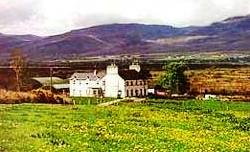
|
| Kilburn/Kilbyrne | The White family resided at Kilburn from the early 18th century to the mid 20th century. The original building was replaced by a new house built in the late 1820s. This building was valued at £35 in the early 1850s. From 1903 to 1938 this house was the home of Colonel James Grove White who compiled the work ''Historical and Topographical Notes on Buttevant, Castletownroche, Doneraile and Mallow.'' The house was partly demolished in the mid 20th century. | |
| Kilburry | The home of Jeremiah Meagher in 1814 and of Robert Maher in the mid 19th century. He held the house valued at £16.15 shillings from William Beasley. Buildings are still located at this site. | |
| Kilcaddan House | William Walker was leasing this property from the Diocese of Derry and Raphoe at the time of Griffiths Valuation, when it was valued at £16. An adjacent mill complex was valued at £18. The National Inventory of Architectural Heritage suggests the current house was built in the 1860s, possibly on the site of an earlier house. |
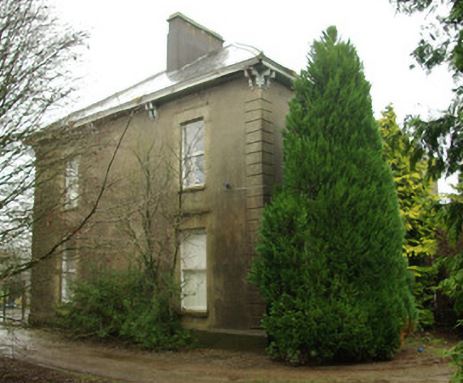
|
| Kilcanavee | In 1850 William Hunt was leasing this property from Lord Waterford's estate when it was valued at £13. A farm exists at the site now. | |
| Kilcarra House | Rev. Rowland Bateman was residing at Kilcarra at the time of Griffith's Valuation, when it was valued at £6 10s. Bary writes that the house had been built by the Fitzmaurices but later came into the possession of the Batemans who lived there until the 1880s. It is still extant and occupied. | |
| Kilcarragh | The home of the Fitzgerald family in the 18th century. Occupied by Austin Kerin in 1814, the Kerins and Fitzgeralds intermarried in the 18th century. The house was valued at £5.10 shillings at the time of Griffith's Valuation and was occupied by Richard Davis who leased it from Francis Fitzgerald. Demolished in the mid 20th century. | |
| Kilcarren | A house occupied by Ralph Smith in 1814 and by A. Carew in 1837. The Ordnance Survey Name Books describe it as "a good dwelling house" in 1841. Alexander Carew, a descendant of Lynn Carew, held the property from Ralph Smith in the mid 19th century when the buildings were valued at £17+. The house is still extant and occupied. |

|
| Kilcaskan Castle | At the time of Griffith's Valuation, William O'Neill Daunt held this property in fee when it was valued at £32. In 1837 Lewis notes that it was held by Daunt and describes it as " a handsome castellated mansion". Both Taylor and Skinner and Wilson refer to it as a seat of the Daunt family in the 1780s. In 1894 Slater referred to it as the seat of Achilles Daunt. In 1906 it was also owned by Achilles Daunt and valued at £12 10s. The Irish Tourist Association Survey of 1944 referred to it as the residence of Miss M.O'Neill-Daunt. It is still extant. |

|
| Kilchreest Glebe | Rev. William O'Grady was leasing this property from the Persse estate & John & Eliza Gloster. It was originally church lands. In 2006 this property was still extant and was offered for sale together with a property known as Killinan House nearby. |

|
| Kilcloghan | A house in the townland of Mount Potter, marked as Thornhill on the First edition Ordnance Survey map but as Kilcloghan House on the 25-inch map of the 1890s. Occupied by Charles Blake junior in 1850 and held from Jeremiah Tully. Subsequently the home of Arthur Netterville Blake. A modern house exists at the site now. | |
| Kilcolgan Castle | Christopher St. George, residing at Kilcolgan Castle, is described as a resident proprietor in county Galway in 1824. In the 1830s Kilcolgan Castle is described as the property of A.F. St. George. This house, part of the St.George estate, was leased by Matthew St.George from Christopher St.George, 1855. At that time Matthew St. George was acting as agent for the Rathbourne estate. Earlier, the Ordnance Survey Field Name books record that he was acting as agent for the estate of Patrick French in the nearby parish of Ballynacourty. In 1894 Slater refers to "Kilcolgan House" as the residence of James St. George. |

|
| Kilcolman | The original residence of the Finch family in the 18th century, Wilson refers to it as the seat of Mr. Finch in 1786. It was occupied by John Finch in 1814 and by Mrs Finch in 1837 and 1840. Leased by the representatives of Mrs W. Finch to Edmund Parker in the mid 19th century when the house was valued at £45. William Finch of Kilcoleman owned 412 acres in the 1870s. Charles Finch occupied this house in 1906. This house no longer exists. | |
| Kilcolman Abbey | Kilcoleman Abbey was the residence of Sir William Godfrey at the time of Griffith's Valuation, when it was valued at £33. Lewis also records it as his residence in 1837. In 1894 Slater referred to it as the seat of Sir John F. Godfrey. In 1906, it was still part of the Godfrey estate and valued at £35 10s.The Irish Tourist Association survey of the early 1940s refers to it as "Godfrey House, a fine type of Elizabethan type mansion". Bary states that the original house, built by the first Godfrey to settle in the area at the end of the seventeenth century, was called Bushfield but that it burned down in 1774 though Wilson still refers to it by this name in 1786 and provides a detailed description of the surroundings. Knightly indicates that a new house was then built by Sir William Godfrey. This house was remodelled twice in the nineteenth century. Sir William Maurice Godfrey sold Kilcoleman in the 1960s and it was demolished in 1977. |
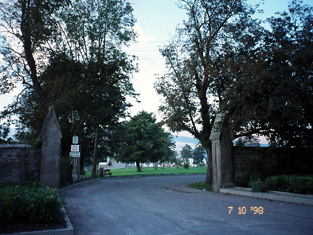
|
| Kilcolman House | Held in fee by William Galway in 1851 when it had a valuation of £38. In 1837 Lewis identified it as the residence of Adderley Beamish, "beautifully situated on the banks of the river Bandon and surrounded by fine plantations". Capt. Beamish had fought in the Napoleonic campaigns at Talavera and Waterloo. He also had a house at Knaresborough in Yorkshire. Kilcolman was burnt in June 1921 during the War of Independence when it was the residence of the Longfield family. It is now a ruin. | |
| Kilcommon Lodge | Home of the O'Donnell family of Erris. It is marked but not labelled on the 1st edition Ordnance Survey map of 1838. At the time of Griffith's Valuation it appears to have been valued at £4 and occupied by James O'Donnell. A house, which serves as a youth hostel, is still extant at the site. See www.kilcommonlodge.ie. |
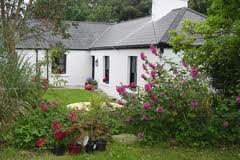
|
| Kilcondy | Kilcondy was occupied by William Davies, medical doctor, in 1837 and by John F. Beale at the time of Griffith's Valuation. Beale held the property from Richard Rye and the buildings were valued at £18+. The Crooke sale rental of 1860 records the leasing of 97 acres of Kilcondy including the dwelling house to Richard Browne Crooke by Richard Tonson Rye in 1840 for 3 lives. John Fleming Beale is given as the tenant. Earlier, in 1786, Wilson refers to Kilcondie as the seat of Mr. Crooke. It is now a ruin. | |
| Kilcoolishal | Thomas Martin occupied a house valued at £18+ in this townland at the time of Griffith's Valuation. He held it from W. B. Hoare. | |
| Kilcooly Abbey | In 1786 Wilson refers to Kilcooley as the residence of Sir William Barker. This was the seat of the Barker and later Ponsonby Barker family in the 18th and 19th centuries. It remained in the possession of the family now known as Ponsonby until the early 21st century. The present house dates from the late 18th century, the family having previously lived in the old abbey. The house was partially destroyed by a fire in 1839 and rebuilt. In the mid 19th century the house was valued at £67.10 shillings. |

|
| Kilcop House | John Coghlan[e] held this property in fee at the time of Griffith's Valuation, when it was valued at almost £36. Later the residence of Mrs. J.H. Bright. The 1945 ITA survey notes it as her residence and provides a description of the art works in the house at that time. | |
| Kilcop Lower | Denis Croker Flynn was leasing this property from the Morris estate in 1848 when it was valued at £11 10s. | |
| Kilcor Castle | The home of the O'Brien family in the 18th and 19th centuries, sold by them in the mid 19th century. Cornelius O'Brien was the occupant in 1837 and at the time of Griffith's Valuation. He held the house valued at £17.15 shillings from James Reid. Kilcor was bought by Francis Doyne Dwyer and later passed to the Phipps family through marriage. In the 1940s the Irish Tourist Association Survey reported that it was the residence of Captain H. Phipps. |
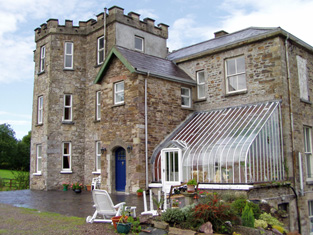
|
| Kilcoran Lodge | A house built in the second half of the 19th century, valued at £46.10 shillings in 1906, the property of Robert Murdock. | |
| Kilcorkey | Denis O'Conor held a property including a mill, valued at £10, at Kilcorkey, barony of Castlereagh, at the time of Griffith's Valuation. In 1749 the Census of Elphin recorded Richard Rutledge, gentleman, as the holder of a property in Kilcorkey. A house and extensive outbuildings still exist at the site but both have been modernised. The outbuildings have been coverted to living accommodation. An impressive standing stone is visible in the field close to the rear of the house. |

|
| Kilcornan | In 1814 Kilcornan House was the residence of T. & C. Redington. Later, in 1837, Lewis recorded it as the seat of T. Redington. At the time of Griffith's Valuation Thomas Redington was the owner of the property, then valued at £100. In 1894 Slater referred to it as the residence of C.T. Redington. In 1906 it was the property of Anne Redington. Kilcornan House is still standing and now forms part of the Brothers of Charity services complex located in the grounds. |

|
| Kilcornan | Originally a Comyn home, by the end of the 18th century Kilcornan was in the possession of the Lysaght family. James Davoren is recorded as resident in 1814. By the time of Griffith's Valuation the house was valued at £1.5 shillings. It is labelled as Kilcornan House on the 1st edition Ordnance Survey map but is not shown on the later 25-inch edition of the 1890s. | |
| Kilcornan Lodge (Ballymahon) | Thomas Murray was leasing this property from Charles Edward Grogan at the time of Griffiths Valuation in the early 1850s, when it was valued at almost £14. In 1814 Leet referred to Kilcornan as the residence of Patrick McDermott. O'Brien details the various occupiers from 1785, the year from which he asserts the house dates. It is still extant. | |
| Kilcorran House | This 18th century house has a date stone over the door 1756. In the mid-19th century it was the residence of William Beatty held in fee. Kilcorran remained the home of the Beatty family until at least the mid-1940s when Rowland Beatty/Betty died there. |
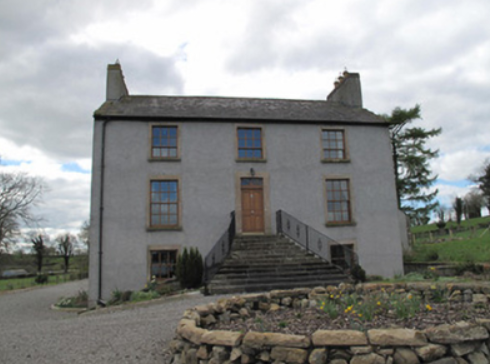
|
| Kilcosgrave | Occupied by Danie Sheahan in 1814. The Ordnance Survey Field Name Book states that Kilcosgrave House was built on the site of the Castle and was formerly the residence of the Langford family. It was then a ruin except for one part which had been converted into a farm house. The name of this house is usually spelt Kilcosgriff. | |
| Kilcow House | Robert A. Thompson was leasing Kilcow House from the Herbert estate at the time of Griffith's Valuation, when it was valued at £17 10s. Bary notes that the Herbert family lived here for a time in the eighteenth century before moving to Muckross. The house is still extant and occupied. | |
| Kilcrea House | In 1750 Smith wrote that Kilcrea was formerly the seat of the Earls of Clancarty, purchased by Captain Hedges from the Trustees of the Hollow Blade Company. In 1786 Wilson mentions the ruins of the castle and abbey of Kilcrea, near to which was a house named Snugborough, the residence of Mr. Keeffe. At the time of Griffith's Valuation Robert Gibbons was the occupier of Kilcrea House. He held the house valued at £20 from John Hawkes [who was leasing from Richard T. Rye]. This house is now a ruin. In March 1851 and July 1853 the estate of William Edward Ellis at Kilcrea, Desart, including Kilcrea House and 422 acres was advertised for sale. It was held on a lease dated 1740 Jonathan Ashe to Jeremiah Sullivan. William E. Ellis was the tenant of the house in 1853. William Sullivan Ellis of Kilcrea was issued with a certificate with respect to the killing of game in 1799 (see "The New Cork Evening Post" 24 March 1800). | |
| Kilcrea House Upper | At the time of Griffith's Valuation, Corliss Hawkes held a house in Kilcrea townland valued at almost £10. This property is labelled Kilcrea House (Upper) on both the 1st and 25-inch edition Ordnance Survey Maps. A building still exists at the site. | |
| Kilcreen Cottage | At the time of Griffith's Valuation, Alexander Elliott was leasing this property to William Harnett, when it was valued at £12 15s. Bary states that this house probably dates to the eighteenth century.William Harnett may have acted as an agent for the Cooke family in the Listowel area. Kilcreen Cottage is still extant and occupied. | |
| Kilcreevin | Lewis records Kilcreevin as a seat of Jemmett Duke in 1837. Griffith's Valuation shows that Jemmett Duke was leasing over 250 acres from the Coopers of Markree in this townland including a property valued at £2. |
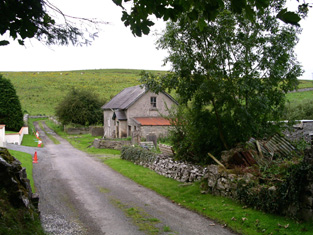
|
| Kilcrone | An early 18th century house, the home of the Hannings in the first half of the 19th century, held by him from Mountifort Longfield at the time of Griffith's Valuation when valued at £30. The sale rental of 1858 records William G. Fitzgerald as the occupant of this house on a temporary basis. This house is occupied and well maintained. |
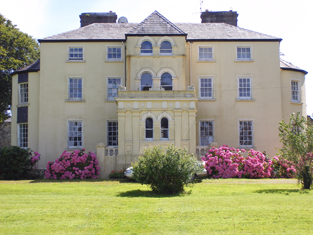
|
| Kilcullen | Edward Delahunty was leasing this property from Lord Waterford's estate in 1848 when it was valued at £10. An extensive farm still exists at the site. | |
| Kilcullen | Kilcullen House is marked on the first Ordnance Survey map. In the mid 19th century the house valued at £8.15 shillings was occupied by Jeremiah Lynch and held from George Vincent. The Lynchs were still resident in the 1870s. |

